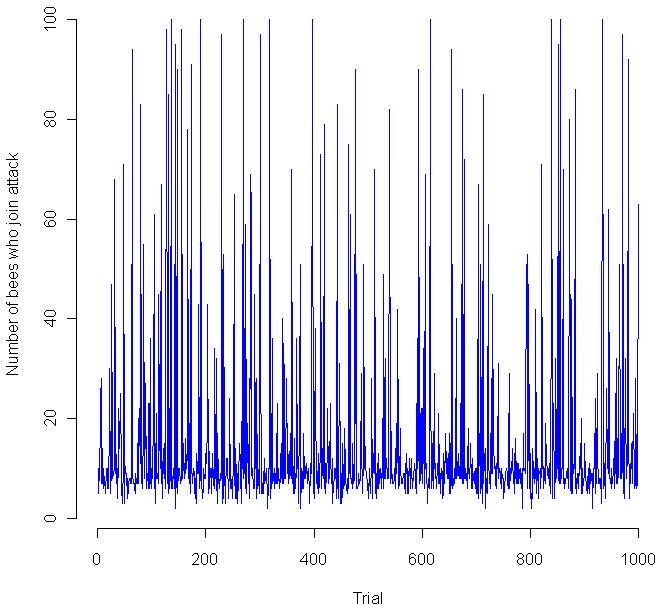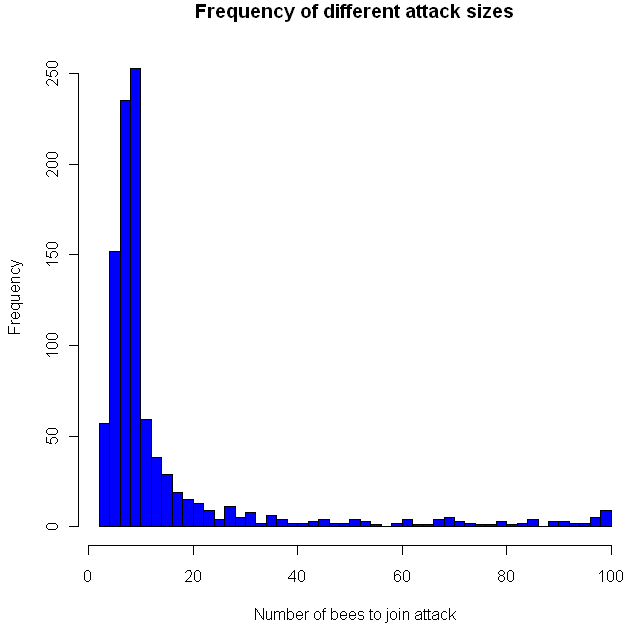In their book “Complex Adaptive Systems”, authors Miller and Page create a theoretic model for bee attacks, based on the real, flying, honey-making, photogenic stingers. Suppose the hive is threatened by some external creature. Some initial group of guard bees sense the danger and fly off to attack. As they go, they lay down a scent. Other bees join in the attack if their scent sensitivity threshold (SST) is reached. When they join the attack, they send out their own warning scent, perhaps triggering an even bigger attack. The authors make the point that if the colony of bees were homogeneous, and every single one had the same attack threshold, then if that threshold was above the initial attack number, then no one else would join in. If it were below, then everyone goes all at once. Fortunately for the bees, they are a motley lot, which is to say a lot more diverse than you would imagine just from looking at the things. As a result, they exhibit much more complicated behavior. The authors describe a model with 100 bees and call their attack threshold “R”. By assuming a heterogeneous population of 100 with thresholds all equal spaced, they note:
“In the hetrogeneous case, a full-scall attack ensues for [latex]R \geq 1[/latex]. This latter result is easy to see, because once at least one bee attacks, then the bee with threshold equal to one will join the fray, and this will trigger the bee with the next highest threshold to join in, and so on…. It is relatively difficult to get the homogeneous hive to react, while the hetrogeneous one is on a hair trigger. Without explicity incorporating the diversity of thresholds, it is difficult to make any kind of accurate prediction of how a given hive will behave.”
I think this last sentence is their way of noting that the exact distribution of sensitivities makes a huge difference in how the bees behave, which indeed it does. I decided to put the bees to the test, so I coded a simulation in the language R (code at the end of this post). I gave 100 virtual apis mellifera a random sensitivity level, chosen from a Uniform(1,100) distribution, then assumed 10 guards decided to attack. How would the others respond? Would a hair-trigger chain reaction occur? The chart at the top shows the results from 1000 trials. Looks pretty chaotic, so here’s a histogram of the results:
As you can see, most of the time the chain reaction dies out quickly, with no more than 20 new bees joining in the attack. However, occasionally the bees do go nuts, sending the full on attack. This happened about 1 percent of the time. Perhaps most interestingly, all of the other attack levels were clearly possible as well, in the flat zone from about 30 to 95. You might want to try playing with the distribution of the sensitivities and see if you get any other interesting distributions. Meanwhile, if you decide to raid a hive, make sure to dip yourself in mud first, that way the bees will think you are nothing but an innocent black rain cloud.
Code in R:
trials = 1000
go = rep(0,trials)
initial = 10
for(i in 1:trials) {
bees = sort(runif(100,1,100))
# Everyone who's threshold is less than the inital amount goes.
going = length(bees[bees initial) {
more = length(bees[bees going) {
# Keep doing this until it stops
going = more
more = length(bees[bees
Tags: bees, collective intelligence, r, simulations



Do you suppose the research on killer bees sheds any light on human behavior, other than the obvious prospects of being attacked by bees. Are there ways in which human swarm like bees? Is the methodology if not the input useful in the human dimension? Bullying comes to mind. And terrorism.
Thanks
Hi Steven,
After the post came out I received a couple emails from a bee expert. Apparently this isn’t a very good model for how bees work (also, they don’t “attack”, they only “defend”).
So far as applying things like this to humans… I don’t see why not. The key is to keep making the model richer until the results “look” like what we see in the real world. Certainly mob situations work in a somewhat similar way: the more people who are engaging in a behavior the more will join in, and everyone has their own “threshold”.
Cheers.
Thanks Matt.
I am also very familiar with bees because my wife is a bee keeper. There is a major difference in the reactions of European bees and African bees. African bees are much more defensive and attack in very large numbers. We open the hives of our European bees without any equipment to protect ourselves from being stung. We have three hives less than 30 yards from our house and I have never been stung. European bees are very defensive when you start taking their honey.
BTW, covering yourself in mud would actually be a bad idea. Bees are attracted to darker objects, so we always wear white when handling them. Unless the mud lightened your skin, I think it would have a negative affect.
Matt – can I reach you off line for a couple of minutes today?
Thanks,
Steven Mintz